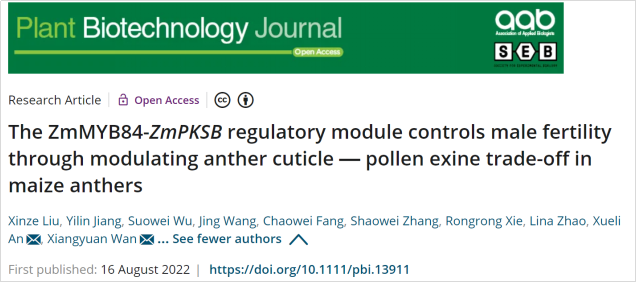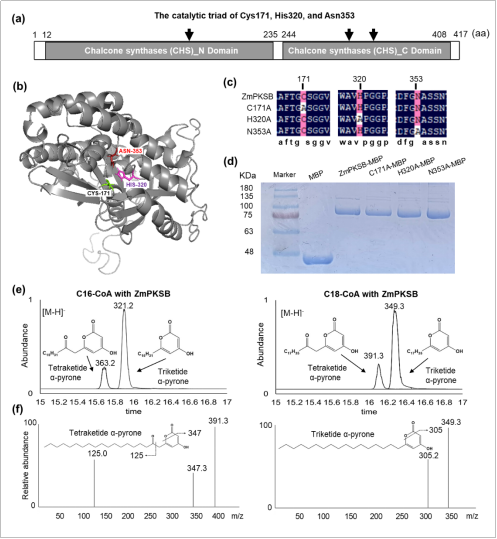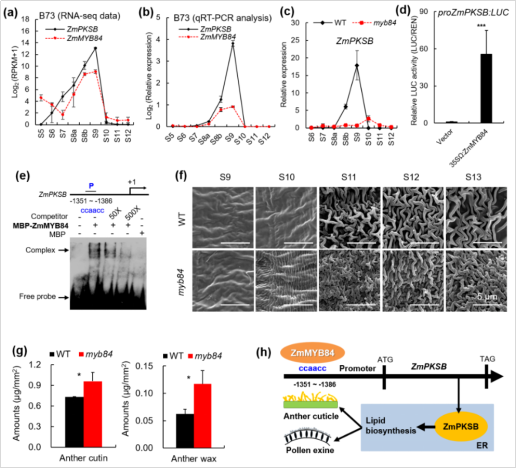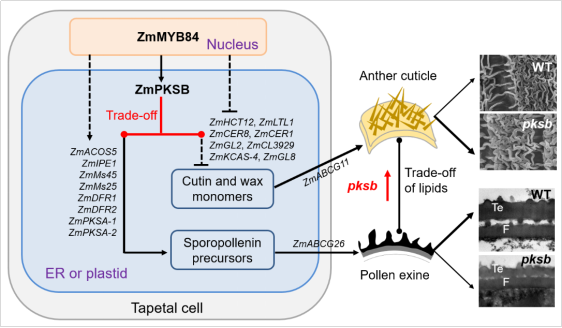Professor Xiangyuan Wan’s team in our university found that the ZmMYB84-ZmPKSB regulatory module controls male fertility through modulating anther cuticle — pollen exine trade-off in maize anthers
Zhongzhi International Institute of Agricultural Biosciences, Biology and Agriculture Research Center, University of Science and Technology

Anther cuticle and pollen exine are two crucial lipid layers that ensure normal pollen development and pollen-stigma interaction for successful fertilization and seed production in plants. Pollen exine is primarily made of sporopollenin, and anther cuticle is mainly composed of cutin polymers and cuticular waxes. The main chemical compositions of these three type materials are lipids and their derivatives that are synthesized and secreted mainly in anther tapetum, the innermost somatic cell layer of anther wall, and then transported onto the outer surfaces of microspores and anthers. Pollen exine formation shares certain common lipid biosynthetic pathways with anther cuticle formation in plant anther tapetum. However, how plants balance the distribution of these lipids and their derivatives in anthers and whether a lipid metabolic trade-off between anther cuticle and pollen exine formation exists to promote their normal development and male fertility remain elusive.
Recently, Professor Xiangyuan Wan’s team discovered for the first time in maize that the ZmMyB84-ZMPKSB regulatory module controls the lipid distribution balance between maize anther cuticle and pollen wall, and determines the development and male fertility. They identified and characterized a maize male-sterility mutant pksb, which displayed denser anther cuticle but thinner pollen exine as well as delayed tapetal degeneration compared to its wild-type (Fig 1). Based on map-based cloning and CRISPR/Cas9 mutagenesis, we found that the causal gene (ZmPKSB) of pksb mutant encoded an endoplasmic reticulum (ER)-localized polyketide synthase (PKS) with catalytic activities to malonyl-CoA and midchain-fatty acyl-CoA to generate triketide and tetraketide α-pyrone. A conserved catalytic triad (C171, H320, and N353) was essential for its enzymatic activity (Fig 2). ZmPKSB was specifically expressed in maize anthers from stages S8b to S9-10 with its peak at S9, and was directly activated by a transcription factor ZmMYB84. Moreover, loss-function of ZmMYB84 resulted in denser anther cuticle but thinner pollen exine similar to the pksb mutant (Fig 3). The ZmMYB84-ZmPKSB regulatory module controlled a trade-off between anther cuticle and pollen exine formation by altering expression of a series of genes related to biosynthesis and transport of sporopollenin, cutin, and wax (Fig 4). These findings provide new insights into the fine-tuning regulation of lipid metabolic balance to precisely promote anther cuticle and pollen exine formation in plants.
This work has been published online in Plant Biotechnology Journal on August 16, 2022.
原文链接:https://doi.org/10.1111/pbi.13911
Xinze Liu1,2,†, Yilin Jiang1,2,†, Suowei Wu1,2,3, Jing Wang1,2, Chaowei Fang1,2, Shaowei Zhang1,2, Rongrong Xie1,2, Lina Zhao1,2, Xueli An1,2,3,*, Xiangyuan Wan1,2,3,*. The ZmMYB84-ZmPKSB regulatory module controls male fertility through modulating anther cuticle — pollen exine trade-off in maize anthers. Plant Biotechnol. J, 2022, August 16, 2022, https://doi.org/10.1111/pbi.13911

Figure 1: Phenotypic and cytological comparison of wild type (WT) and pksb mutant.

Figure 2: Enzyme activity analysis of the recombinant ZmPKSB proteins.

Figure 3: ZmPKSB is activated by ZmMYB84 and the ZmMYB84-ZmPKSB regulatory module controls lipid biosynthesis for anther cuticle and pollen exine formation.

Figure 4: The ZmMYB84-ZmPKSB regulatory module controls a trade-off between anther cuticle and pollen exine formation by regulating genes related to biosynthesis and transport of sporopollenin, cutin, and wax in maize anthers.

